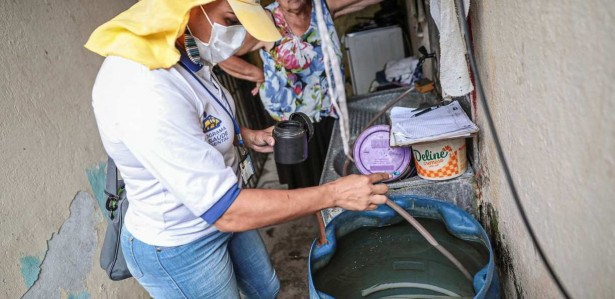With an increase of nearly 400% of Reported cases of arboviruses (dengue, chicungunha and Zika) Between January and June of this year, if compared to the same period last year, Recife has a third of the city’s neighborhoods with a very high risk of infection by the mosquito that causes these diseases, Aedes aegypti. According to the latest survey of the Aedes aegypti Rapid Index (LIRAa), which was conducted by the Municipal Health Department in May, there are 31 neighborhoods classified in this category. The municipality has 94 districts in total.
As of June 26 this year, 8,824 cases of arbovirus have been reported, including 3,845 cases of dengue fever, 4,860 cases of chikungunna virus, and 119 cases of Zika virus. Of this total, 1,160 cases of dengue and 3,029 cases of chikungunna have been confirmed. The city reports that compared to the same period in 2020, there was an increase of 394% of reported cases and 368% of confirmed cases.
It is considered a very high risk when the infection index is greater than or equal to 4. The hero neighborhoods in the capital of Pernambuco are all located in the northern region and with an equal index, 9. They are Jaqueira, Monteiro, Parnamirim and Tamarineira. Overall, Recife gave an overall score of 2.7%, an infection rate considered high risk.
To calculate the index in each neighborhood, the municipal health department checks 100 properties in the community. The index will be the number of addresses where mosquito outbreaks have been found. For example: In one hundred properties searched in Jaqueira, in nine of them, municipal agents found breeding sites for the herb Aedes aegypti. This is why Jaqueira has a hit rate of 9.
According to the latest Aedes aegypti-transmitted arbovirus epidemiological bulletin, released last week, using an interruption of probable cases from May 2 to June 26 (which indicates the period of last active transmission of sexually transmitted viruses), the neighborhoods that presented the largest number of probable cases They are: Água Fria (374), Dois Unidos (330), Campo Grande (288), Várzea (254) and Alto José Bonifácio (249).
Also according to the same document, when analyzing disease risk, the neighborhoods with the highest detection rates per 10,000 inhabitants were: Recife (355.5), Zombi (209.3), Alto José Bonifacio (185, 9), Campina do Barreto (173.6) and Torreão ( 171.8).
By age group, the distribution of confirmed cases of arboviruses indicates a concentration in people aged 20–59 years (61.9%), all the way to the economically active population.
See below 31 neighborhoods with very high risks of dengue, chikungunna and Zika, according to Recife City Council (the number next to the neighborhood name indicates the index, which ranges from zero to one hundred)
Jackfruit – 9
Montero – 9
Parnamariam – 9
Tamarind – 9
floodplain – 8.7
Two brothers – 8.3
Sítio dos Pintos – 8.3
lamb – 8
Zombie – 8
Shooting line – 7.6
Iputinga – 6.5
clods – 6.5
6.2 . cold water
Affected- 5.8
Derby – 5,8
Spinheiro – 5,8
Thanks – 5.8
New discovery – 5.2
Jardim Sao Paulo – 5
Crossroads – 5.1
Race Track – 5.1
Rosarinho – 5,1
Tower – 5.1
Jordan – 5.1
Cohab – 4.7
Stubborn Brasilia – 4.5
Pina – 4,4
Santo Amaro – 4.4
Guabiraba – 4.3
Ironwood – 4.3
Bebebe – 4
how to prevent Aedes Egyptian
Water boxes, cisterns and cisterns
Keep water tanks, basins, and cupboards well covered at all times.
Bottles and tires
Do not accumulate bottles and tires in the house. In this case, leave the empty bottles upside down and store the tires in a covered place, avoiding the accumulation of rainwater inside them. Use the pick-up service at 3355.7727
External refrigerator drawer
At least once a week, remove the water from the outer drawer of the refrigerator and wash it with soap.
the plants
Fill pots of plant pots with sand to the brim.
rubbish, destroy, destroy
Put the trash in plastic bags and keep the trash tightly closed. Do not throw clothes on abandoned land. Check the collection time.
tractor
Remove leaves, twigs, and anything that might obstruct the passage of water through the gutters.
animal drink
Wash animal drinking fountains with brush, soap, and water weekly.
ralos
Make sure not all drains in the house are clogged. Clean it at least once a week, and if you don’t use it, leave it open.
plank
Do not leave rainwater on the slab.
Buckets, vases and pots
Weekly washing indoors, with brush and soap, jars, pots, buckets, and tanks used to store water: When not in use, it should be turned over and stored protected from rain. Attention: all these utensils must be washed and poured water in a dry place.

“Wannabe internet buff. Future teen idol. Hardcore zombie guru. Gamer. Avid creator. Entrepreneur. Bacon ninja.”

